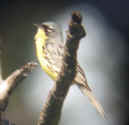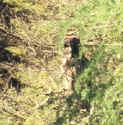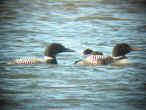Birding the Northwoods
June 2002
Click
on photos for larger view.
 |
 |
| Black-backed Woodpecker |
Great Gray Owl |
Photos by
Richard K. Walton (used with permission) |
June
6-7 -- We parked our motorhome at Hartwick Pines State Park near
Grayling, Michigan, and early the next morning we joined a ranger-led
tour to see the Kirtland’s Warbler.
The weather was cool and clear, and a number of
Kirtland’s Warblers sang from high perches above the young
 Jack Pines. To me it
sounded like “chip-chip, chee-chee, swee-sweet,” rapid and rising
at the end. This
endangered bird appears to be doing well here, but only through careful management
of their habitat and constant trapping of Brown-headed Cowbirds.
Jack Pines. To me it
sounded like “chip-chip, chee-chee, swee-sweet,” rapid and rising
at the end. This
endangered bird appears to be doing well here, but only through careful management
of their habitat and constant trapping of Brown-headed Cowbirds.
June
8-10 -- We moved on to Michigan’s Upper Peninsula.
Our primary goal here was the Black-throated Blue Warbler.
The sources we consulted recommended the Tahquamenon Falls
Trail, Miner’s Falls Trail and the Songbird Trail at AuTrain Lake
Campground. We hiked all
three trails and occasionally heard the buzzy, rising “sweer sweer
swee swee zeee” or “beer beer beer beer beeee” of the
Black-throated Blue Warbler among the songs of Magnolia, Tennessee,
and Black-throated Green Warblers, Veeries, Hermit Thrushes and
others. But we never were
able to get a look at a male Black-throated Blue. Bob did see a female, but I missed it. And each time we’d stop to look, hordes of
mosquitoes descended on us. We
had already bought mosquito head nets and covered ourselves with
industrial-strength mosquito repellent, but the mosquitoes still
hovered around us hungrily and found vulnerable spots to bite whenever
we stood still.
Since we needed to be in Duluth, Minnesota, by Monday evening,
June 10, to pick up our ABA convention packets and get last minute
instructions about field trips, etc., I resigned myself to a “heard
only” entry on my life list for the Black-throated Blue.
Our chances of finding that bird were not as good in Minnesota
as they were in Michigan.
Before leaving Michigan’s U.P. however, we visited Seney NWR.
Not many warblers here. Seney
is a wetland managed primarily for waterfowl.
But we did find American Black Duck – a life bird for me, and
we especially enjoyed seeing the display of the Common Snipe at dusk
and hearing their winnowing flight “song.”
 June
11-15 -- The ABA Convention in Duluth, Minnesota, was very
interesting, educational and exhausting.
We learned a great deal in Paul Lehman’s workshop on Weather
and Bird Migration, and in Dick Walton’s workshop on Minnesota Bird
Songs. The field trips
started around 4:30 in the mornings and generally had us back in
Duluth by around 3:00 PM. By
the third day of field trips, I was a zombie – and a cranky one at
that. But we did pick up
a few lifers: Yellow-bellied
Flycatcher, Black-backed Woodpecker, and Mourning Warbler were all new
for me; and Connecticut Warbler was new for Bob.
After the last field trip, we both went to bed early and
enjoyed the luxury of sleeping late the next morning.
June
11-15 -- The ABA Convention in Duluth, Minnesota, was very
interesting, educational and exhausting.
We learned a great deal in Paul Lehman’s workshop on Weather
and Bird Migration, and in Dick Walton’s workshop on Minnesota Bird
Songs. The field trips
started around 4:30 in the mornings and generally had us back in
Duluth by around 3:00 PM. By
the third day of field trips, I was a zombie – and a cranky one at
that. But we did pick up
a few lifers: Yellow-bellied
Flycatcher, Black-backed Woodpecker, and Mourning Warbler were all new
for me; and Connecticut Warbler was new for Bob.
After the last field trip, we both went to bed early and
enjoyed the luxury of sleeping late the next morning.
June
16-17 -- After checking Kim Eckert’s new 2002 edition of A Birder’s Guide to Minnesota and inquiring of other
local birders, we headed north for one last attempt to find the
Black-throated Blue Warbler. Mount
Oberg on the north shore of Lake Superior was supposed to have a
nesting pair or two.
As we were getting out of the car at the Mount Oberg Trail
parking lot, a fifty-ish couple greeted us with complaints about the
tent caterpillars. The
man grumbled, “I wouldn’t go back up there if you paid me!
But you can do what you want.”
We’d been dealing with the “army worms” all week on the
ABA Convention field trips, so we proceeded on up the trail undaunted.
As we hiked up through the mostly-denuded aspens and birches,
we batted with sticks to clear our path through the caterpillar threads and webs. Occasionally we’d
stop to pick caterpillars off each other.
At least they didn’t bite, but I didn’t like the idea of
caterpillars crawling inside my collar.
We enjoyed hearing Nashville, Magnolia, Blackburnian,
Chestnut-sided, and Black-throated Green Warblers, Ovenbirds and
Red-eyed Vireos, accompanied by the ethereal music of Veeries and
Hermit Thrushes. Eventually,
we emerged into open scrubby habitat with a beautiful view of Lake
Superior – but no Black-throated Blue Warblers.
We returned to the deciduous woods we had just passed through
and picked up a slow, buzzy “beer beer beer beer beeee,” rising on
the last note. (For some, the mnemonic that works best is “I am
so la-zee.”) We
searched the dense vegetation for the singing bird.
Bob spotted it first and helped me get on it – a gorgeous
male singing from the top of a mid-story snag.
The warbler looked almost completely black except for his snowy
white belly and the white patch on his wings.
Success, at last!
June
18 -– Driving into Ely, Minnesota, we passed a grouse along the
road. It didn’t flush
until we were beside it, so we got good looks.
It was a female Spruce Grouse, also known as Fool’s Hen
because of its reluctance to flush when approached.
This was a lifer for both Bob and me – our last for the trip.
 June
20 -– On our way south, we stopped at Sax-Zim Bog.
We had birded it on the final day of ABA field trips, but
wanted to try for a photo of the Great Gray Owl.
We ran into Dick Walton there, who was videotaping the owl.
Bob snapped a few shots of it, even though it was perched some
distance away by this time. Dick said the owl had been much closer earlier and
graciously offered to E-mail one of his photos to us (as well as a
photo of the Black-backed Woodpecker seen on the ABA trips).
We visited and birded with him a while before saying our
good-byes and continuing our trip homeward.
June
20 -– On our way south, we stopped at Sax-Zim Bog.
We had birded it on the final day of ABA field trips, but
wanted to try for a photo of the Great Gray Owl.
We ran into Dick Walton there, who was videotaping the owl.
Bob snapped a few shots of it, even though it was perched some
distance away by this time. Dick said the owl had been much closer earlier and
graciously offered to E-mail one of his photos to us (as well as a
photo of the Black-backed Woodpecker seen on the ABA trips).
We visited and birded with him a while before saying our
good-byes and continuing our trip homeward.
After three weeks on the road, our trip list totaled 152
species, with 22 warbler species, 10 ducks, 9 flycatchers, 7
woodpeckers, 7 sparrows, and 6 swallow species.
We enjoyed hearing the birds and learning their songs as much
as seeing them. Some of the most memorable and beautiful
songsters in the world breed in the Northwoods of Michigan and
Minnesota.
If you ever plan to go north in search of these birds, be sure
to spend some time learning their songs.
In the dense forests and undergrowth where many of these birds
breed, they are much more easily heard than seen.
I highly recommend Dick Walton’s Birding
By Ear tapes and CDs. And
if you ever have an opportunity to attend a bird song workshop led by
Dick Walton, don’t miss it. Bob
told me he didn’t think he would ever get a handle on learning all
the different warbler songs with his inability to hear high pitches,
but after Dick Walton’s class, he felt much more confident in his
ability to identify warblers and other birds by their songs.
One final word in closing.
There may be easier places to see many of these migrant
songbirds (such as the Texas Coast).
But the migrants along the coast are out of context and in many
ways incomplete. They’re generally not singing; they’re not in
their breeding habitats; and they’re usually exhausted and not
behaving normally. On
their northern breeding grounds, however, these birds not only are
singing, but actively courting, defending territories, and then
feeding and protecting young. And
all of this they’re doing exactly where they belong.
Palm and Connecticut Warblers and Yellow-bellied Flycatchers in
muskeg, spruce and tamarack bogs.
Alder Flycatchers in nearby stands of aspen, alder and birch. Kirtland’s
Warblers in young Jack Pine groves; Magnolia Warblers
in low conifers. Mourning,
Canada, and Black-throated Blue Warblers in cool dense understory
thickets, along with Veeries and Hermit Thrushes.
Look for priceless moments and memories like these in the
Northwoods where these birds breed.
Dorothy
Metzler
|
 |
|
 |
| Common Loons with young |
|
Kirtland's Warbler
|
Photos by Bob
Metzler;
Canon G2
digital camera with
Leica APO Televid 77 scope |
|
 |
Trilliums
and Wood Fern; photo by Dorothy Metzler;
Minolta Maxxum 7000i camera with
Tamron 28-200 mm lens,
Kodak Max 400 film
|

East
Coast Trip: South Carolina to New Hampshire,
September 2002
Banff
Area Trip: September 2001 trip to Canada
New
Mexico Trip:
Taos, Santa Fe and Albuquerque areas, August 2001
Photos
Page 1: Photos of friends and family
Photos
Page 2: Ice, snow (Dec. 2000) and flood (Mar.
2001)
Photos
Page 3: Family photos -- 2001
Photos
Page 4: Another flood in December 2001
Photos
used with permission. Copyright © 2002-2007. All rights
reserved. All
material on this Web site is intended only for the personal
information and enjoyment of visitors to this Web site and may not be
reproduced or published elsewhere without permission of the respective
author or photographer.
This page last updated
May 03, 2009.

Home
| Caddo Lake | Other
Places | Birds | Butterflies
Native Plants
| Native Fish | Cat
Stuff | Photo Album



![]()
![]()
![]()